Welcome to the sixth and final (?) article in the series The Skills of Netrunner.
Now we have come this far. You have been with me all the way, and I’m glad to have you here still! I hope there has been some value for you in the previous parts, especially regarding concepts to communicate about the game. I have now been a part of this game and its community for two and a half years, and honestly I am having as fun as ever! I feel like overall the game is in a good spot right now, and getting better. There are some notable exceptions to this, but I’ll get there, I promise. Now, one of my personal hobbies is to try to read Damon’s mind, to see if I can discern the direction the game is going from the outside.
This is what we are going to do now, we will see if I succeed. Be aware: this is the lengthiest article yet! In fact, many of the points I want to get across here would have been very difficult were it not for concepts defined in previous articles. If you are massively confused by terms used here I must refer you to the earlier parts of the series (most notably articles one, two and three).
This game we all play is one of the hardest types of games to design and balance, in all categories. This is something I would like to delve into for a moment, as I feel the designers and balance testers do not get enough credit for the fantastic work they manage to do. It is important to consider this whenever you encounter perceived problems with the game, or its balance.
Not only does Netrunner have the immense pool of cards that come with a collectible card game, it has a moving meta as new cards are released and will soon have a rotating meta. Thus the game needs to be balanced at all points in time for it to continue to stay successful. It also needs to be balanced at all skill-levels to be fun! As if this was not enough it is an asymmetric game! This is the only game of its type to have such a large difference in how the two different sides play, introducing a lot of additional complexity. The last and final challenge here has to be noted, the game is not digital. It is a physical card-game and it is very difficult (and costly!) to patch balance-issues post-release.
Luckily, we have seen some swift action with the new boss in town. Damon has introduced the MWL which i must tip my hat to congratulate on as solving balance problems in an elegant way. May it live long, and prosper.
The Slowly Shifting Meta
From the previous articles you can see just how complex and interesting the game can be to play, and that it can prompt this type of discussion among players. Hell it prompted me to write a minor book on the subject. However, the game is unsurprisingly not without its blemishes, and I have observed some things I personally think would make the game an even more solid design. I feel that the design-team have correctly identified many of the issues, and are currently in the process of eliminating them with things like the MWL, rotation and new cycles. However these things take time and problems may lie dormant due to meta-shifts for a long time. Developing effective counter-strategies may also take a long time due to player-reluctance to do the hard work of exploring the card-pool.
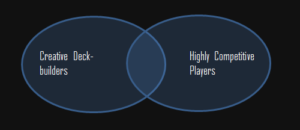
One reason for this can be seen in the diagram above. The number of players that are very competitive (and thus require highly tuned decks) and the number of players engaged in creative deck building are generally not the same people. There is an overlap between the groups, but doing the type of work required is hard and I believe that mostly it is these few players in the overlap who have the greatest chances of actually moving a stagnant meta.
Disclaimer: Note that i mean creative deck building here, not iterative, tuning or perfecting existing concepts with potential. The players who continually and consistently come up with new concepts changing the meta are the point of the above graph.
Another aspect of the game that leads to some strategies being discovered slowly is that if there are many powerful decks that have low complexity available, this means fewer people will put in the effort required to both develop and get good with a complex deck concept. I believe this sometimes frustrates the designers, but here they actually do have themselves to blame. We will look more into this aspect below.
One thing we often hear whispered by Damon is that he believes there are good dormant counter-strategies out there. This may well have a lot of truth to it, but it is difficult to say. While many competitive players stick to what they know until it stops working, it may also be difficult for the designer of the game to properly evaluate the absolute power-level of some strategies in development. Another aspect of this is that as the meta shifts, it may have a hard time moving away from a local maxima in the design space. While there may be multiple metas that have different high-power decks in a certain card-pool, the current meta may be stuck in a local maxima where few players have both the creative skill and the game skill to see outside of that and break the stagnant patterns. This likely applies both to the various metas around the world, the so-called internet-consensus meta as well as the development-meta that Damon leans on to balance the game.
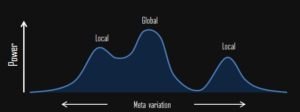
This may result in the real-world metas developing differently from the development meta, whether this was because the development meta failed to pick up on very powerful strategies or the real-world meta is stuck in group-think consensus, this holds true. This is, of course, the fault of neither. This shit is hard. Likely both of these contain a piece of the truth. I believe firmly in applying the MWL to counter these problems, and I fully stand by Damon wielding that as a tool to break up a stagnant meta dominated by few powerful decks. In fact, a new MWL to me is often more exciting than new cards coming out! The MWL is like a finger that firmly presses down on the bubbles above, and moves the maxima to another point. It attempts to flatten the curve, and make more choices of deck valid at high tiers of play.
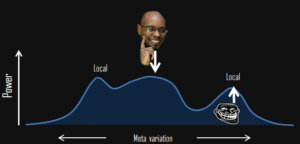
I would like to see even more broadly applied MWL, and even consider some more restricting and maybe even bans. This is because the presumption that new cards will fix old problems is not always true. New cards can give new strategies, or they can lift old strategies. To some extent counter-cards can help, but what MWL does is push down the power of cards and combos, and new cards have a hard time doing this without turning it into a game of cards beat cards. Now, I will concentrate on some broad aspects of the game, and the meta game, that I feel can be generally improved. We will start with my first major comment on the game.
First however, a disclaimer:
I do not with comments in this article mean to judge players using options i will discuss. Competitive players should use any efficient options that are available to win, that is their role and privilege.
Mono-Strategic Decks
What do I mean by this term? From article three we know what I consider a strategic deck to be. This is a deck that has a powerful in-built game plan that it aims to enact more or less regardless of the opponent. A mono-strategic deck is a deck with very little flexibility and a very powerful core game plan. These are decks like DLR Anarchs, False Echo/DDoS (dyper), Cerebral Imaging Combo and 54-card Prison Kill IG.
These decks share some characteristics; they usually care very little about the opponent’s deck, apart from a few counter-cards. They are usually, but not always, easy to improve quickly with and easier to play under pressure (CI may be a bit of an exception here). They shut down a lot of avenues of interaction in the game by making their game plan the only game plan, which means that if the opponent is unable to counter their game plan they will lose. Now this is not a problem in itself, I consider the mono-strategic deck to be a valid way to play the game, and they do some good things for the game as well. They keep other mono-strategic decks in check, and give variety and challenge to mid-range decks. They prevent mid-range decks from just cramming in power-cards for example. They also act as good meta-calls to counter other strong decks.
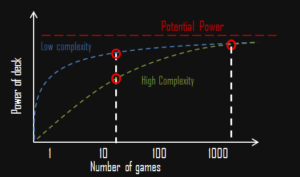
The problem.
The problem is their power-level, especially at anything but very high-skill play. We also see their performance at higher skill-tiers show that they can fight very well up there. A DLR deck won worlds 2015, 54-card IG swept the meta this year and at worlds 2016 we have seen Dyper decks fare very well along with Boom! Combos et cetera. Usually this is a problem both with power level but also with low complexity. This means that these decks are easier to use (especially under pressure) than a mid-range deck and difficult to counter properly for certain decks. It also means that they are way more powerful at lower skill-levels making for an un-fun experience, potentially driving people out of the game before they manage to ‘git gud’. This is a problem regardless of balance at the highest tiers.
Another issue with low-complexity decks being strong is that in a pressured environment like a tournament, competitive players will choose a deck that is less energy intensive to play. That requires less concentration. Mono-strategic decks usually fill this role as the skill they utilize, strategy, is the one that most benefits from pre-learning. While tactics and yomi are more sensitive to disruption and fatigue, mono-strategy (or non-changing strategy) requires less energy to play. You can learn to play such a deck well and keep playing it well under pressure. Naturally, many competitive players will choose a low-complexity deck over a high-complexity deck if they are at equal power level.
If a mono-strategic deck is very powerful it often requires specific counter-cards to be combated, which means that if you don’t pack them you will have a very unfavourable matchup and if you do pack them the game turns into a more luck-driven process where you win if you manage to locate them in time. These matches can for many players take out a lot of fun from the game, simply because playing out a 10/90 matchup is not very fun or interesting, and they have very few decisions if the counterplay is a specific card. This is destructive for the game.
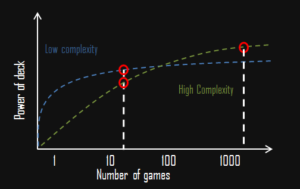
The solution.
I believe that if you bring a meta-adapted, well-tuned mid-range deck you should not have to encounter a worse matchup than 40/60 in a tournament. If you do choose to bring an especially strategic or off-meta deck then it is no problem if some of your matchups are 10/90, since that was your choice. As a Personal Evolution player I know that my Eater/Keyhole matchup is likely 10/90 at best, but bringing PE to a tournament is my choice. If I bring a well-tuned good-stuff Palana with 17 ICE however, I will not consider this my fault. Then, unless it is a skill-issue, it is a game-issue. What I consider a game-issue is different from a balance-issue mind you, we have the MWL for that. A game-issue is when parts of the game are invalidated or removed, or very few skill-testing decisions are taken in a game.
If mono-strategic decks are powerful it shifts the game from playing Netrunner into playing the Netrunner meta-game. I believe that the power of these decks should be on the level where they can do really well as a good meta-call, but not as an all-round option. The most powerful decks in the game should always be the mid-range decks as they usually have the highest complexity and requires the most use of all four skills to play well. A player should be rewarded for playing a complex deck at high tiers.

Yes, horses are douchebags.
Another issue is that powerful mono-strategic decks destroy the validity of mid-range decks by drawing them in different directions. If mono-strategic decks are too powerful it means that such decks with opposite strategies force a mid-range deck to cram in enough defense that it undermines their core effectiveness versus other matchups. It also turns the game into a game of draw-the-card-first which naturally eliminates skill and adds a lot of randomness.
Note that this could equally well be a problem if tactical decks were too strong (it would be a game of instant ‘take-that’) or if Yomi decks were too strong (would bypass other important skills). This is not currently the case however (except for Blackmail.. we will get to that). My point here is that is a deck-type that invalidates or minimizes other types of skills in the game it should not be top-tier. If this is not the case some aspects of the game are lost. This is a current problem that has been growing for a while. We want the best decks to require interactive skill to play effectively.

The way i would prefer it to look.
The Woes of Glacier
We all know glacier is having a hard time at the moment. If we look at typical mid-range concepts over the history of Netrunner I believe various forms of glacier are the most typical. Other strategies like fast-advance, rush or various forms of kill all go a little bit more towards the ends of the spectrum. As I told you earlier, I’m trying hard to read Damon’s mind when it comes to where the game is going. I have been working on various forms of Palana-deck for the last year, and I will go into my experience with this here. See this as a little bit of Netrunner history.
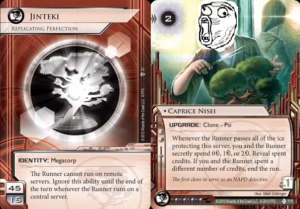
Historically, glacier decks like RP and HB foodcoats have had very strong late-game scoring plans. This has largely been due to a few powerful defensive upgrades like Ash or Caprice Nisei, but also due to powerful agendas (Nisei MkII) or the ability to blank-install 2/3 agendas in taxing servers. Now, I am a fan of the Psi-game. Contrary to many I do not consider Yomi to be ‘pure luck’. However the Psi-game cannot be allowed to bypass good play in the other skills too much, and I have always considered Caprice Nisei to be a bit on the powerful end with lack of good counterplay. A skilled player could play around Nisei in many ways by pre-trashing, playing denial et cetera, but it was a bit too hard to be fair and the variance of a Yomi-game so parallel to the other game mechanisms really killed many strategic and tactical avenues of skill. Yomi-decisions need to have consequences for the rest of the game-state, otherwise there is no predictability to exploit and thus less skill even in the Yomi. Ash is better design in my opinion, I have little to say on Ash but that it is and has always been a fair card.
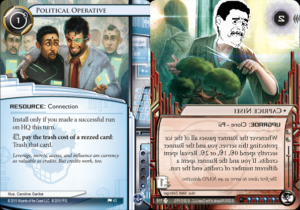
In the Mumbad cycle we saw the release of Political Operative and Councilman. I was extremely impressed with the design of these two cards. They are both interactive (or limited), requires effort to use and requires counterplay to counter. I believe that these two cards fixed many issues with both Ash and Caprice (as well as giving some counterplay to Marcus Batty and Jackson Howard among others). We saw competitive players go down to two Caprice, which is a sign this worked as intended. Caprice as a card was still a bit too powerful in matchups without these cards, but at least this introduced a counterplay that was fair. This is the time when I started to play Palana.
As I mentioned before, I’m a huge deck-hipster. I prefer playing somewhat off-meta and suddenly problems I had with the glacier archetype seemed to have dampened. I looked forward to delving into exploring these types of decks. My objective has been to develop a glacier-deck with a lot of tactical choices, which in this case means tricksy and powerful ICE.
This largely went well, I played a Palana with multiple interesting defensive upgrades, more notable utilizing synergy between Nisei, Batty and Navi Mumbai City Grid and Grail ICE. I still did not like the matches where my opponent had little counter play to this, and I won by the sheer power of Batty-trash or Caprice-scoring, but at least there were many tense and exciting games to be had.
In comes Rumor Mill like a hyper-charged space-powered troll kitten.
Wow.
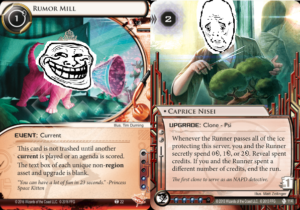
Not only did this single card kill off the whole interesting game-space of defensive upgrades and their counter plays, it did so with very little skill attached to it and no counter play. As if that was not enough it also hit Jackson, so is played not only as a specific counter but as a general good-stuff card. Now I will save kitty some face here soon, but first I need to get off my chest how incredibly uninteresting and destructive this design is as a card and for the game. It requires nothing to play, is cheap and can be replayed using event-recursion and Deja-Vu to the end of days. It single-handedly takes 50/50 matchups and makes them 90/10. It also has no efficient counterplay.
I’m sorry, Damon, for the previous sentences. I suspect I know what you are up to however, you cheeky bastard, and I am eagerly anticipating the next part of this master-plan. What I think happened here is that Rumor Mill is not intended as a card so much as a way to pre-emptively phase out cards that will rotate anyway, and some of which were not especially good design in the first place (Caprice) or may have outlived their purpose (Jackson). As collateral it killed off glacier.. or did it?
I have since taken this as a challenge and have been playing mostly Palana since Rumor Mill hit. The thing here is that I believe the design team intends glacier to be viable, but in the way it was originally was intended to be. This is, mainly using ICE as defences and maybe some upgrades, but not relying on them as a core strategy. This requires playing a much more efficiency oriented and rushy game, forcing the runner to sap his or her economy to get to the agendas you are rushing out. It is actually not working half bad, in most matchups. It was really hard to adjust to this type of play style however, and it requires some re-wiring of the brain of what is good and bad from doing the end-game Caprice-thing. I play three Scarcity of Resources and one Voter Intimidation for resource control, and this really crushes some late-game runners. You should try it.
There are problems however. While I have no trouble accepting that glacier will not have the powerful end-game options that it has had historically, it is still in need of some defensive upgrades once installing ICE becomes too inefficient. Marcus Batty is an example of better design here; it is a one-use upgrade which is powerful late game but weak early-game. This is the perfect design-space for defensive upgrades. I would not take my Palana to a high-end tournament yet, there needs to be some way of messing with the runner using defensive upgrades for it to be a valid choice. Defensive upgrades also introduces a necessary element of uncertainty to runs, which is required for there to be any good Yomi once ICE is rezzed. I eagerly anticipate Damon anticipating this, and solving this problem for us with upcoming cards.
A last comment on the state of glacier is the card that I consider to be most destructive to the game at the moment: Blackmail (in conjunction with Valencia). This is a card that makes it extremely easy to counter rush-play as a strategy, and requires very little skill to use. It has the same options of recursion as Rumor Mill, and bypasses a lot of decks and a lot of skill-space. To effectively play around Blackmail you need pre-rez ICE effects or Bad Publicity-removal. I have tried both, and the options available greatly dilute the power of a mid-range deck. This is especially a problem with mono-strategic decks as described above. I consider it fairer as a two-card combo with Corporate Scandal, but that is still not very interesting as an option.
If I was allowed a single game-design decision in Netrunner I would restrict Blackmail to one-per-deck or ban it outright. Phew.
Enough vitriol from a left-out glacier player, let’s get into an interesting design-problem next!
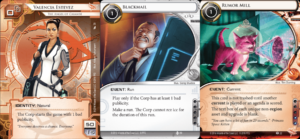
A serious problem.
The Agenda Design Problem
Since the beginning of time, 2012, when Netrunner was re-released, a debate has raged on the correct design for the different types of agendas in the game. Many good commenters have discussed this before, and I will only summarize their thoughts briefly here before continuing.
2/3 Agendas
- Good point-to-effort-ratio
- Can be blank-installed
- Needs to be somewhat limited for game-balance
2/4 Agendas
- Decent point-to-effort ratio
- With powerful effects on scoring they are balanced and fun
1 /2 Agendas
- Good point-to-effort ratio
- Can be fast-advanced
- Takes up valuable card-slots
1/3 Agendas
- Bad point-to-effort-ratio
- Can be blank-installed
- With powerful enough effects can see play, but usually not
- Takes up valuable card-slots
3/5 Agendas
- Bad point-to-effort ratio
- Needs much setup to be scored
- Decreases agenda-density, giving card slots
- Increases risk and variance in a deck
We will deal with two types of agendas here, the 3/5 and the 1/3. They both have a similar problem. They both make your deck worse compared to other agendas, since they are difficult to design well enough to counter their inherent weaknesses. A reason for this is that apart from the points gained, an agenda is balanced by giving the corp a powerful effect once scored. Remember, points are worth nothing to the corps board state unless it is the final point.
There is a problem when it comes to 1/3’s in that since they cost so much efficiency to score and for that to be worth it they need to give enough back to include in a deck. A 1/3 needs to have enough utility to the corp, and traditionally this has not been the case. The way to do this without making them overpowered I feel is to design 1/3’s that feed into specific strategies of specific decks. False Lead is a good example of this. Quantum Predictive Model is another. I believe the design team is closing in on good design-space here, but I feel that they are somewhat conservative with the general power-level of 1/3’s so far. Using them as tools that are useful for a specific thing has shown success.
If we are indeed going back towards a mid-range meta as I suspect Mr. Stone is aiming for then the 1/3 agenda is the perfect tool for baiting runs! Some players do not like using traps due to their Yomi-like nature, and for some strategies traps do not work well. Using 1/3’s to bait runs and slow down the runner economy is the perfect way in my mind to use these little buggers. A good 1/3 can be bluffed as any other agenda and gives the runner a single point only. I have tried this strategy in Palana, mainly with 2 Chronos Projects (another well-designed 1/3) and it works decently. I would like to see some 1/3’s specifically intended to use as run-bait, maybe giving the corp back the resources invested in them if stolen (2 credits per advancement) or acting as mini-traps. 1 net damage per advancement anyone?
Also very interesting in my mind is the problem with the 3/5 agendas. Here we have quite of an opposite problem! The 3/5’s that see play are either defensive (making them harder to steal) or provide some extremely powerful upsides once scored (High-risk investment, Cleaners) or are Global Food initiative (I suspect MWL is upcoming for this one).
Some have argued that for 3/5’s to see more play they need more powerful abilities. I disagree with this statement. They are already plenty powerful. The problem is not with the power-level of their abilities but with the high variance they introduce into your deck. If a 3/5 is not scored it risks allowing the runner to win on 3 agendas instead of 4 (this is huge!). If a 3/5 is scored with an even more powerful ability it would risk unbalancing the game.
No, the problem here is that they are risky to include and difficult to score to get use out of. As it is, it is mainly feasible to use a 3/5 as your final agenda to close out the game, since scoring one early is a great risk, and scoring one any-time costs a lot of resources.
I see protective agendas as a great design space to use for 3/5’s! It buffers some of their downside, the risk of being stolen, and makes decks including them more consistent. The Future Perfect is an excellent example, especially as it now has a counter play in Film Critic. I would like to see even more variants on this in other factions. While the Future Perfect protects itself in R&D I can imagine seeing 3/5’s that protect themselves in the actual scoring remote, similar to an in-built defensive upgrade. An example would be forcing the runner to trash one card per advancement as an additional cost to steal.
The other route I can imagine going with 3/5’s would be to give the corp benefits for advancing them, or even when the runner steals them! This would mean that a 5/3’s ability can be counted on by the corp even if the runner gets to it in a match. This could potentially mitigate the downside of it, if it lets the corp improve its board state afterwards. An example would be a 3/5 giving the corp a single credit at the start of turn whether it is scored or stolen, like half a never-ending Corporate Sales Team. Scoring or stealing a 3/5 should be one of the more exciting moments in a game of Netrunner, and should be of great importance to both sides!
This concludes my thoughts on agendas.
Looking Ahead
Actually, my confidence that the game will increase in greatness and my problems above being solved as we go on has improved the last cycle. I wrote this piece remembering a whole bunch of similar, broad design-problems that I once did think about that are now gone. Actually way more of them than the above three. Looking back I was surprised I could only find three.
First, during the last cycle we have seen tags become relevant! For all the CTM dominance  the last cycle somewhat spoiling this phenomenon I feel like a long-standing game-issue has been solved. Tags are a thing for more than kill-decks now, and that brings in a whole new dimension to the game. I love this! We see NBN ICE depend on tags, we see cards remove tags as a cost. This will only get more interesting, and the obvious birth-problems of this archetype will be solved by MWL. Further, kudos to the design of Hard Hitting News, I find this card to fit perfectly in the triad of active tagging, and a great addition to the game. In my opinion it is purely Breaking News that is the overpowered tagging mechanism.
the last cycle somewhat spoiling this phenomenon I feel like a long-standing game-issue has been solved. Tags are a thing for more than kill-decks now, and that brings in a whole new dimension to the game. I love this! We see NBN ICE depend on tags, we see cards remove tags as a cost. This will only get more interesting, and the obvious birth-problems of this archetype will be solved by MWL. Further, kudos to the design of Hard Hitting News, I find this card to fit perfectly in the triad of active tagging, and a great addition to the game. In my opinion it is purely Breaking News that is the overpowered tagging mechanism.
 On another note we have seen a very positive effect with resources becoming more relevant and more of a point of interaction between corp and runner. I don’t think the full potential of this has yet bloomed, but with a lot of high-impact runner resources like Temujin and Net Mercur there is a larger incentive for corps to use anti-resource cards. Resources should be riskier to use as a counterbalance to their power, and we haven’t quite been there before. I have now Voter Intimidated many a Kati, Net Mercur and Film Critic and prevented economy set-up with Scarcity of Resources. This will be a thing as soon as glacier swings back i’m sure.
On another note we have seen a very positive effect with resources becoming more relevant and more of a point of interaction between corp and runner. I don’t think the full potential of this has yet bloomed, but with a lot of high-impact runner resources like Temujin and Net Mercur there is a larger incentive for corps to use anti-resource cards. Resources should be riskier to use as a counterbalance to their power, and we haven’t quite been there before. I have now Voter Intimidated many a Kati, Net Mercur and Film Critic and prevented economy set-up with Scarcity of Resources. This will be a thing as soon as glacier swings back i’m sure.
The dominance of fast-advance has been solved! This almost-mono-strategy type o f play has been fixed, reducing fast-advance to a balanced game-mechanic and skillful play. Now
f play has been fixed, reducing fast-advance to a balanced game-mechanic and skillful play. Now
doing fast-advance requires complicated combos, or a large economic investment. I actually really like the concept and flavour of Astroscript Pilot Program, and as a once-per-deck it suits the game well as a power-play, similar to Philotic Entanglement.
We are seeing ICE becoming more relevant with some high-impact expensive IC E being released. This shows Damon knows what he is doing yet again, as this type of ICE ha
E being released. This shows Damon knows what he is doing yet again, as this type of ICE ha
s largely been ignored before, leaving a large part of the game-space in the dustbin. We also see much better ICE design nowadays for taxing ICE where breaking the subs is almost as bad as taking them in the face. Perfect design space. This also works towards fixing a big problem with the meta, which is AI breakers+D4vid. We already see this working.
Say what you will about Rumor Mill, but the problem with late-game![]() corp decks has been solved (albeit crudely). The times of RP dominance, where the corp was the one controlling the late-game, are over. This is as it should be. The designershave done a lot to counter this issue, although I felt like Rumor Mill was like bringing a sledgehammer down on the problem instead of a wrench, I feel confident that they are working on putting those pieces back together. However, it can’t come soon enough.
corp decks has been solved (albeit crudely). The times of RP dominance, where the corp was the one controlling the late-game, are over. This is as it should be. The designershave done a lot to counter this issue, although I felt like Rumor Mill was like bringing a sledgehammer down on the problem instead of a wrench, I feel confident that they are working on putting those pieces back together. However, it can’t come soon enough.
Weyland strategies and the find-the-counter type play of meat-damage is well on it![]() s way to being fixed. The new anti-damage cards are way more skill-testing and less direct c
s way to being fixed. The new anti-damage cards are way more skill-testing and less direct c
ounters than Plascrete, and we have seen more consistency with cards like Consulting Visit. I have played some Blue Sun recently and it is fun and quite decent. I hope this archetype will return, and the fact that Boom! Is three influence is just a minor gripe I have here. Yes, PriSec should also have been Weyland.
Overall I look at the direction this game is going knowing that the designers are doing what they can to improve the game and more importantly seem to be identifying where the game needs improvement. There are mishaps here and there, that is what the MWL is for. I really look forward to the MWL, and as a final note for this article, and this whole series I am going to make some wishes. It is almost Christmas time, after all.

MWL Wishlist – Balance-problems
These are wishes related to tuning the balance of the game. I wish for all factions to be viable and represented with at least 1 archetype at a given time, and these changes I believe would go towards that.
- Global Food Initiative, we have seen this card replacing 3-pointers in all decks. As a general card for glacier I think this is balanced, what is overpowered however is the Breaking News + Exchange of Information-combo. By the way, I think Exchange is a perfectly well-designed card which is a large part of solving the tag-design-problem.
- Sensie Actors Union. We need to specifically target CTM, as the ID turned out to be slightly too powerful. It has a consistently powerful early game, and while I like the tactical nature of the deck, it is way too good. This will nerf the archetype suitably. Despite the counter-cards in recent datapacks those will not fix the powerful early-game CTM is known for.
- Mimic, we have seen that Anarchs still are the most powerful faction. This is due to the power and flexibility of their in faction cards, together with the ease with which they can do denial. Mimic is better than criminal sentry-breakers, and now that Anarchs have a new breakier in MKUltra they can very well pay extra for this card that is too good for the faction. The anarch faction strength should be barriers not everything. I am confident that they will survive anyway.
- Beth-Kilrain-Chang, I’m thinking that maybe by boosting all credit limits with 5 this card would have been balanced. It is not a game-breaker, but above the power-curve at its cost. This is an autoinclude in all shaper decks at the moment, and as a unique drip-econ card this just introduces power-creep and randomness (due to the 1-limit).
- Temujin Contracts, I thought long and hard about this one, and I’m kind of sad it is here. This is the perfect card to solve the criminal-problem. I do not think it is as unbalanced as it first seems. It is just a tad too powerful out of criminal though, which is why it is here. I think with three influence this would have been perfectly fine with the limitations in the criminal faction.
Restricted Wishlist – Game-problems
These are all wishes related to fixing things I consider serious game-problems. This goes deeper than balance, and a restriction on these types of effects will make them less consistent and more of auxiliary power-options (like Astro or Philotic), also meaning their respective decks need additional game-plans that include playing Netrunner.
- Blackmail. Only used in Valencia. Hits a central mid-range archetype hard (glacier). Requires little skill to use. Combos with new power-cards like En Passant well. Not good for the game at all, if the point of the game is to be interactive and skill-testing.
- Data Leak Reversal. It will rotate, but frankly I can’t wait. If Caprice was ‘phased out’ early, please take care of this problem as well. These decks paired with Eater/Siphon are a major problem.
- False Echo. Noticing a theme? Yeah. I don’t find this archetype particularly good design either, and very mono-strategist. While interesting once, these decks cannot be allowed to override vast areas of the skill-space in the game.
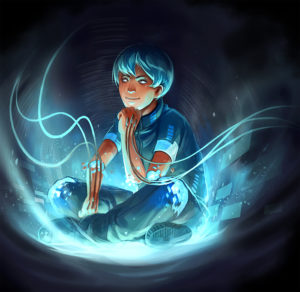
Summary
Look at those lists! Look how short they are! In a game with ~1000 cards is that nothing else than an achievement?
If you actually read this far, I hope you enjoyed the read and that it was valuable to you. What started as an idea to discuss the skill-space in Netrunner turned out to be a 50-page essay and almost 20000 words! Yikes. I have to control myself next time such an idea pops up. Please hit me over the head with a playmat if that happens, will you?
I have taught myself a whole lot being forced to think about these concepts, and I hope I managed to teach some things to some of you, and that I managed to provoke some ideas and some discussion. I am very welcoming in discussing any of the opinions and ideas presented here, in fact I hope that I will be challenged on them. New ideas are born in the friction between old ones, after all.
And to all of you, I wish you happy holidays as we take a short break from our excellent game and fantastic community to wait for the next MW.. er.. I mean celebrate the birth of some old dude and eat food and stuff..
//User:Elusive -signing off




